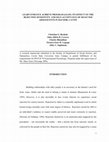Papers by Abby Sapitanan
causes and symptoms. This will tell the situationof the patient why and when it occured.
Thesis Chapters by Abby Sapitanan

The study was conducted to determine the level of Rejection Sensitivity and Self-Acceptance of Se... more The study was conducted to determine the level of Rejection Sensitivity and Self-Acceptance of Selected Adolescents of Bacoor, Cavite. The study focused on reducing the level of Rejection Sensitivity and enhancing the level of Self-Acceptance utilizing Learn, Enhance, Achieve Program (LEAP) which has been made by the researchers and has been validated by three experts.
The participants of the study was composed of nineteen (19) randomly selected adolescents of selected from Bacoor, Cavite. Pre-test and post-test was supported by True experimental research design method and the Learn Enhance Achieve Program (LEAP) was improved by 6 modules developed by the researchers to calibrate the effect of high self-acceptance and to lower the rejection sensitivity level of the participants in the study. To ensure the data gathered, the researchers used statistical tools such as: Frequency Distribution, Aritmetic mean, Kolmogorov- Smirnov test, Dependent t-test and Independent sample t-test, Welch’s T-test, and Analysis of covariance (ANCOVA).
There is no significant difference in the mean scores of the two groups. The control and experimental group do not differ in initial rejection sensitivity levels however the mean score obtained from experimental group (M = 84.00) is statistically higher than the mean score obtained from the control group (M = 70.00) in terms of self-acceptance thus, null hypothesis is rejected.
There is no significant difference between the pre-test and post-test mean scores of the participants from control and experimental group in terms of rejection sensitivity and self acceptance.
There is a significant difference in the mean scores of the two groups. The rejection sensitivity post-test mean score obtained from experimental group (M = 7.83) is statistically less than the rejection sensitivity post test mean score obtained from the control group (M = 10.80). From these results it can be deduced that the program has a positive effect on the level of rejection sensitivity of the participants. In terms of self-acceptance, after controlling for the pre-test score, there is a highly significant difference in the self-acceptance post-test mean score between the experimental and control groups.
To determine the significant differences of the variances, analysis of variance and Welch F-test were used. Among the hypotheses, hypothesis one and four were rejected while hypotheses two and three were accepted.
Drafts by Abby Sapitanan
A thesis proposal that seeks to derive a contextual meaning of bahala na and construct a scale th... more A thesis proposal that seeks to derive a contextual meaning of bahala na and construct a scale that will measure the extent as to which a person utters bahala na both in positive and negative context.

The study was conducted to determine the level of Rejection Sensitivity and Self-Acceptance of Se... more The study was conducted to determine the level of Rejection Sensitivity and Self-Acceptance of Selected Adolescents of Selected Churches from Bacoor, Cavite. The study focused on reducing the level of Rejection Sensitivity and enhancing the level of Self-Acceptance utilizing Learn, Enhance, Achieve Program (LEAP) which has been made by the researchers and has been validated by three experts.
The participants of the study was composed of nineteen (19) randomly selected adolescents of selected from Bacoor, Cavite. Pre-test and post-test was supported by True experimental research design method and the Learn Enhance Achieve Program (LEAP) was improved by 6 modules developed by the researchers to calibrate the effect of high self-acceptance and to lower the rejection sensitivity level of the participants in the study. To ensure the data gathered, the researchers used statistical tools such as: Frequency Distribution, Aritmetic mean, Kolmogorov- Smirnov test, Dependent t-test and Independent sample t-test, Welch’s T-test, and Analysis of covariance (ANCOVA).
There is no significant difference in the mean scores of the two groups. The control and experimental group do not differ in initial rejection sensitivity levels however the mean score obtained from experimental group (M = 84.00) is statistically higher than the mean score obtained from the control group (M = 70.00) in terms of self-acceptance thus, null hypothesis is rejected.
There is no significant difference between the pre-test and post-test mean scores of the participants from control and experimental group in terms of rejection sensitivity and self acceptance.
There is a significant difference in the mean scores of the two groups. The rejection sensitivity post-test mean score obtained from experimental group (M = 7.83) is statistically less than the rejection sensitivity post test mean score obtained from the control group (M = 10.80). From these results it can be deduced that the program has a positive effect on the level of rejection sensitivity of the participants. In terms of self-acceptance, after controlling for the pre-test score, there is a highly significant difference in the self-acceptance post-test mean score between the experimental and control groups.
To determine the significant differences of the variances, analysis of variance and Welch F-test were used. Among the hypotheses, hypothesis one and four were rejected while hypotheses two and three were accepted.

The study was conducted to determine the level of Rejection Sensitivity and Self-Acceptance of Se... more The study was conducted to determine the level of Rejection Sensitivity and Self-Acceptance of Selected Adolescents of Selected Churches from Bacoor, Cavite. The study focused on reducing the level of Rejection Sensitivity and enhancing the level of Self-Acceptance utilizing Learn, Enhance, Achieve Program (LEAP) which has been made by the researchers and has been validated by three experts.
The participants of the study was composed of nineteen (19) randomly selected adolescents of selected from Bacoor, Cavite. Pre-test and post-test was supported by True experimental research design method and the Learn Enhance Achieve Program (LEAP) was improved by 6 modules developed by the researchers to calibrate the effect of high self-acceptance and to lower the rejection sensitivity level of the participants in the study. To ensure the data gathered, the researchers used statistical tools such as: Frequency Distribution, Aritmetic mean, Kolmogorov- Smirnov test, Dependent t-test and Independent sample t-test, Welch’s T-test, and Analysis of covariance (ANCOVA).
There is no significant difference in the mean scores of the two groups. The control and experimental group do not differ in initial rejection sensitivity levels however the mean score obtained from experimental group (M = 84.00) is statistically higher than the mean score obtained from the control group (M = 70.00) in terms of self-acceptance thus, null hypothesis is rejected.
There is no significant difference between the pre-test and post-test mean scores of the participants from control and experimental group in terms of rejection sensitivity and self acceptance.
There is a significant difference in the mean scores of the two groups. The rejection sensitivity post-test mean score obtained from experimental group (M = 7.83) is statistically less than the rejection sensitivity post test mean score obtained from the control group (M = 10.80). From these results it can be deduced that the program has a positive effect on the level of rejection sensitivity of the participants. In terms of self-acceptance, after controlling for the pre-test score, there is a highly significant difference in the self-acceptance post-test mean score between the experimental and control groups.
To determine the significant differences of the variances, analysis of variance and Welch F-test were used. Among the hypotheses, hypothesis one and four were rejected while hypotheses two and three were accepted.








Uploads
Papers by Abby Sapitanan
Thesis Chapters by Abby Sapitanan
The participants of the study was composed of nineteen (19) randomly selected adolescents of selected from Bacoor, Cavite. Pre-test and post-test was supported by True experimental research design method and the Learn Enhance Achieve Program (LEAP) was improved by 6 modules developed by the researchers to calibrate the effect of high self-acceptance and to lower the rejection sensitivity level of the participants in the study. To ensure the data gathered, the researchers used statistical tools such as: Frequency Distribution, Aritmetic mean, Kolmogorov- Smirnov test, Dependent t-test and Independent sample t-test, Welch’s T-test, and Analysis of covariance (ANCOVA).
There is no significant difference in the mean scores of the two groups. The control and experimental group do not differ in initial rejection sensitivity levels however the mean score obtained from experimental group (M = 84.00) is statistically higher than the mean score obtained from the control group (M = 70.00) in terms of self-acceptance thus, null hypothesis is rejected.
There is no significant difference between the pre-test and post-test mean scores of the participants from control and experimental group in terms of rejection sensitivity and self acceptance.
There is a significant difference in the mean scores of the two groups. The rejection sensitivity post-test mean score obtained from experimental group (M = 7.83) is statistically less than the rejection sensitivity post test mean score obtained from the control group (M = 10.80). From these results it can be deduced that the program has a positive effect on the level of rejection sensitivity of the participants. In terms of self-acceptance, after controlling for the pre-test score, there is a highly significant difference in the self-acceptance post-test mean score between the experimental and control groups.
To determine the significant differences of the variances, analysis of variance and Welch F-test were used. Among the hypotheses, hypothesis one and four were rejected while hypotheses two and three were accepted.
Drafts by Abby Sapitanan
The participants of the study was composed of nineteen (19) randomly selected adolescents of selected from Bacoor, Cavite. Pre-test and post-test was supported by True experimental research design method and the Learn Enhance Achieve Program (LEAP) was improved by 6 modules developed by the researchers to calibrate the effect of high self-acceptance and to lower the rejection sensitivity level of the participants in the study. To ensure the data gathered, the researchers used statistical tools such as: Frequency Distribution, Aritmetic mean, Kolmogorov- Smirnov test, Dependent t-test and Independent sample t-test, Welch’s T-test, and Analysis of covariance (ANCOVA).
There is no significant difference in the mean scores of the two groups. The control and experimental group do not differ in initial rejection sensitivity levels however the mean score obtained from experimental group (M = 84.00) is statistically higher than the mean score obtained from the control group (M = 70.00) in terms of self-acceptance thus, null hypothesis is rejected.
There is no significant difference between the pre-test and post-test mean scores of the participants from control and experimental group in terms of rejection sensitivity and self acceptance.
There is a significant difference in the mean scores of the two groups. The rejection sensitivity post-test mean score obtained from experimental group (M = 7.83) is statistically less than the rejection sensitivity post test mean score obtained from the control group (M = 10.80). From these results it can be deduced that the program has a positive effect on the level of rejection sensitivity of the participants. In terms of self-acceptance, after controlling for the pre-test score, there is a highly significant difference in the self-acceptance post-test mean score between the experimental and control groups.
To determine the significant differences of the variances, analysis of variance and Welch F-test were used. Among the hypotheses, hypothesis one and four were rejected while hypotheses two and three were accepted.
The participants of the study was composed of nineteen (19) randomly selected adolescents of selected from Bacoor, Cavite. Pre-test and post-test was supported by True experimental research design method and the Learn Enhance Achieve Program (LEAP) was improved by 6 modules developed by the researchers to calibrate the effect of high self-acceptance and to lower the rejection sensitivity level of the participants in the study. To ensure the data gathered, the researchers used statistical tools such as: Frequency Distribution, Aritmetic mean, Kolmogorov- Smirnov test, Dependent t-test and Independent sample t-test, Welch’s T-test, and Analysis of covariance (ANCOVA).
There is no significant difference in the mean scores of the two groups. The control and experimental group do not differ in initial rejection sensitivity levels however the mean score obtained from experimental group (M = 84.00) is statistically higher than the mean score obtained from the control group (M = 70.00) in terms of self-acceptance thus, null hypothesis is rejected.
There is no significant difference between the pre-test and post-test mean scores of the participants from control and experimental group in terms of rejection sensitivity and self acceptance.
There is a significant difference in the mean scores of the two groups. The rejection sensitivity post-test mean score obtained from experimental group (M = 7.83) is statistically less than the rejection sensitivity post test mean score obtained from the control group (M = 10.80). From these results it can be deduced that the program has a positive effect on the level of rejection sensitivity of the participants. In terms of self-acceptance, after controlling for the pre-test score, there is a highly significant difference in the self-acceptance post-test mean score between the experimental and control groups.
To determine the significant differences of the variances, analysis of variance and Welch F-test were used. Among the hypotheses, hypothesis one and four were rejected while hypotheses two and three were accepted.
The participants of the study was composed of nineteen (19) randomly selected adolescents of selected from Bacoor, Cavite. Pre-test and post-test was supported by True experimental research design method and the Learn Enhance Achieve Program (LEAP) was improved by 6 modules developed by the researchers to calibrate the effect of high self-acceptance and to lower the rejection sensitivity level of the participants in the study. To ensure the data gathered, the researchers used statistical tools such as: Frequency Distribution, Aritmetic mean, Kolmogorov- Smirnov test, Dependent t-test and Independent sample t-test, Welch’s T-test, and Analysis of covariance (ANCOVA).
There is no significant difference in the mean scores of the two groups. The control and experimental group do not differ in initial rejection sensitivity levels however the mean score obtained from experimental group (M = 84.00) is statistically higher than the mean score obtained from the control group (M = 70.00) in terms of self-acceptance thus, null hypothesis is rejected.
There is no significant difference between the pre-test and post-test mean scores of the participants from control and experimental group in terms of rejection sensitivity and self acceptance.
There is a significant difference in the mean scores of the two groups. The rejection sensitivity post-test mean score obtained from experimental group (M = 7.83) is statistically less than the rejection sensitivity post test mean score obtained from the control group (M = 10.80). From these results it can be deduced that the program has a positive effect on the level of rejection sensitivity of the participants. In terms of self-acceptance, after controlling for the pre-test score, there is a highly significant difference in the self-acceptance post-test mean score between the experimental and control groups.
To determine the significant differences of the variances, analysis of variance and Welch F-test were used. Among the hypotheses, hypothesis one and four were rejected while hypotheses two and three were accepted.
The participants of the study was composed of nineteen (19) randomly selected adolescents of selected from Bacoor, Cavite. Pre-test and post-test was supported by True experimental research design method and the Learn Enhance Achieve Program (LEAP) was improved by 6 modules developed by the researchers to calibrate the effect of high self-acceptance and to lower the rejection sensitivity level of the participants in the study. To ensure the data gathered, the researchers used statistical tools such as: Frequency Distribution, Aritmetic mean, Kolmogorov- Smirnov test, Dependent t-test and Independent sample t-test, Welch’s T-test, and Analysis of covariance (ANCOVA).
There is no significant difference in the mean scores of the two groups. The control and experimental group do not differ in initial rejection sensitivity levels however the mean score obtained from experimental group (M = 84.00) is statistically higher than the mean score obtained from the control group (M = 70.00) in terms of self-acceptance thus, null hypothesis is rejected.
There is no significant difference between the pre-test and post-test mean scores of the participants from control and experimental group in terms of rejection sensitivity and self acceptance.
There is a significant difference in the mean scores of the two groups. The rejection sensitivity post-test mean score obtained from experimental group (M = 7.83) is statistically less than the rejection sensitivity post test mean score obtained from the control group (M = 10.80). From these results it can be deduced that the program has a positive effect on the level of rejection sensitivity of the participants. In terms of self-acceptance, after controlling for the pre-test score, there is a highly significant difference in the self-acceptance post-test mean score between the experimental and control groups.
To determine the significant differences of the variances, analysis of variance and Welch F-test were used. Among the hypotheses, hypothesis one and four were rejected while hypotheses two and three were accepted.
The participants of the study was composed of nineteen (19) randomly selected adolescents of selected from Bacoor, Cavite. Pre-test and post-test was supported by True experimental research design method and the Learn Enhance Achieve Program (LEAP) was improved by 6 modules developed by the researchers to calibrate the effect of high self-acceptance and to lower the rejection sensitivity level of the participants in the study. To ensure the data gathered, the researchers used statistical tools such as: Frequency Distribution, Aritmetic mean, Kolmogorov- Smirnov test, Dependent t-test and Independent sample t-test, Welch’s T-test, and Analysis of covariance (ANCOVA).
There is no significant difference in the mean scores of the two groups. The control and experimental group do not differ in initial rejection sensitivity levels however the mean score obtained from experimental group (M = 84.00) is statistically higher than the mean score obtained from the control group (M = 70.00) in terms of self-acceptance thus, null hypothesis is rejected.
There is no significant difference between the pre-test and post-test mean scores of the participants from control and experimental group in terms of rejection sensitivity and self acceptance.
There is a significant difference in the mean scores of the two groups. The rejection sensitivity post-test mean score obtained from experimental group (M = 7.83) is statistically less than the rejection sensitivity post test mean score obtained from the control group (M = 10.80). From these results it can be deduced that the program has a positive effect on the level of rejection sensitivity of the participants. In terms of self-acceptance, after controlling for the pre-test score, there is a highly significant difference in the self-acceptance post-test mean score between the experimental and control groups.
To determine the significant differences of the variances, analysis of variance and Welch F-test were used. Among the hypotheses, hypothesis one and four were rejected while hypotheses two and three were accepted.